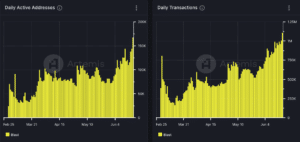Ethereum L2 Blast Posts All-Time Excessive in Day after day Transactions and Users Sooner than Airdrop

Blast, an Ethereum layer 2 blockchain community, recorded all-time highs in day to day transactions and active users on Thursday, earlier than its airdrop scheduled for June 26.
In step with info from blockchain analytics company Artemis, the number of wallet addresses active on Blast, a tough proxy for active users, better than doubled from roughly 73,500 addresses before everything up of June to about 168,400 as of June 20.
The amplify in active addresses coincided with an uptick in day to day transactions as successfully. Users generated 640,1000 transactions on the principle day of June. Since then, the number of transactions has grown almost 72% to 1.1 million transactions, per Artemis’ most present info.
Study More: What Is Blast on Ethereum? A Beginner’s Data
The all-time highs in day to day transactions and users come as these within the Blast ecosystem are gearing up for the protocol’s airdrop, situation to occur in no longer as a lot as one week. “Dapps must distribute all Gold and Points to users by June 25, 8 a.m. ET in account for for it to be counted,” wrote the Blast personnel on X two days ago.
Half of of the Blast airdrop is allotted to points, that are earned by users basically basically based on the balance of their wallets, whereas the final 50% has been earmarked for “Gold,” which is for decentralized functions constructing natively on Blast. In step with Blast’s protocol paperwork, “Gold is supposed to be mature as incentives for Dapp yell. This implies that Dapps can accept as true with to give 100% of any Gold they make to their users.”
Blast’s document ranges earlier than its airdrop also is available within the identical week interoperability protocol LayerZero and rival layer 2 blockchain community ZKsync spread out their airdrop claims, aiming to reward their contributing users.
Sybils
The elevated community exercise in addresses and transactions for the months-aged layer 2 blockchain community is an illustration of Blast’s recognition among users. On the opposite hand it might also be safe to deem that hundreds of these addresses and transactions stem from Sybil tactics, throughout which one particular person acts as many users by utilizing better than a single wallet.
The blueprint of a Sybil attack is to simulate the roughly exercise rewarded in an airdrop, distorting the on-chain image of user exercise so the attackers can, on this case, claim a higher piece of the airdrop. Making an attempt to title and disqualify addresses engaged in Sybil activities has change into a identical old practice at some level of a protocol’s preparation in conducting its token technology event.
Low-scale Sybil activities would mean a relative handful of Blast addresses had been duplicates, whereas loyal Sybil farmers would possibly perchance also use thousands of wallet addresses to generate transactional exercise on the community.
Source credit : unchainedcrypto.com

